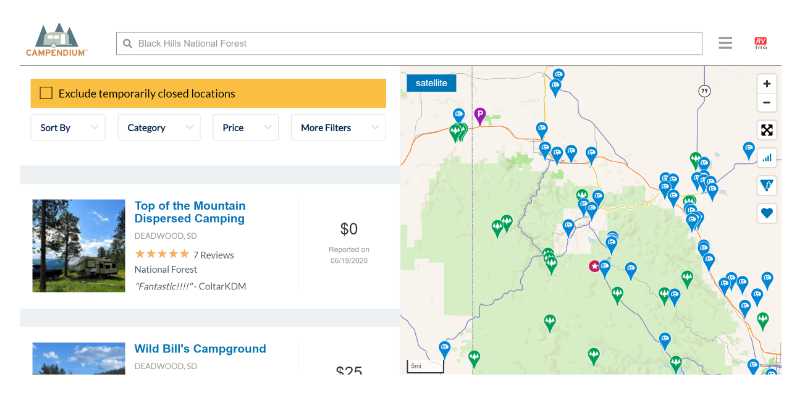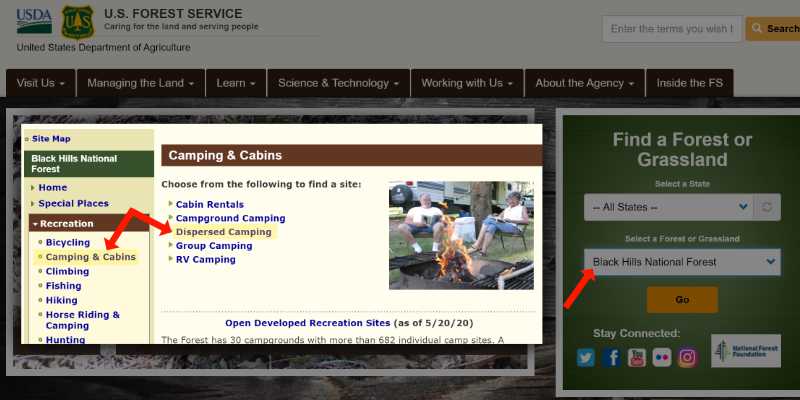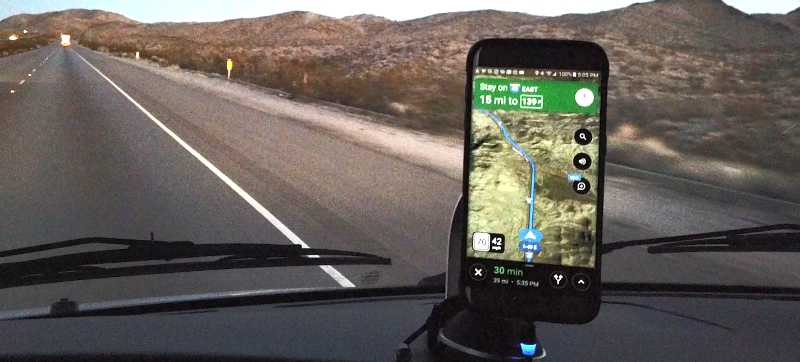Building a list of great boondocking sites will happen as you boondocking more. The best sites are often the ones you’ve simply stumbled upon by pure luck. Favorite campsites shared by fellow RVers also have a way of becoming your favorite too. So don’t be afraid to ask RVers you meet “Where’s your favorite boondocking spot?” They might just tell you.
When visiting new parts of the country, researching nearby boondocking sites will become part of your planning process. However, you just don’t know what you’ll get until you arrive. So having a boondocking plan A, B and maybe C is the best way to avoid the stress of finding a spot. I’ll give you several resources here to help streamline the process.
Finding boondocking spots has historically been a challenging process. The information has just been hard to find. When you do find it, it’s often incomplete, unreliable and scattered all over the place. Luckily there are online resources available now that simplify the process of finding boondocking sites across the country.
First let’s start by clarifying what a boondocking site is. Then I’ll tell you how to find them.
What is a Boondocking Site?
Before we clarify what we’re calling a boondocking site, we need to first agree on what boondocking is.
The term boondocking is often generalized to represent any kind of overnight stay in a self-contained camper or RV. You basically have no power, water or sewer hookups. You’re on your own to take care of your own needs.
You might be traveling and staying overnight at Walmarts, casinos and rest stops. Or you might be dry-camping at an RV rally for 5 days without hookups. Or you might be camping in the Arizona desert on BLM land for 14 days at a time. Let’s agree that it’s all boondocking.
A boondocking site would then be any place where overnight camping in a self-contained camper or RV is allowed. No hookup campgrounds, parking lots, casinos, public land, private land, beaches, truck stops, and public rest stops might all be considered potential boondocking sites.
Since most long term boondocking occurs on undeveloped public land, let’s start there. There are specific guidelines you’ll need to follow.
Can You Camp Anywhere on Public Land?
No. It’s not a free-for-all. We can’t just camp anywhere we want. Instead we need to educate ourselves on the various regulations and restrictions associated with these areas.
Most established boondocking sites are located in designated dispersed camping areas. Vehicles need to be self-contained. Some dispersed camping areas are very large and wide open while others have a limited number of campsites. In general, camping is allowed within 100 feet of established roads.
Camping is generally allowed anywhere in a National Forest area unless posted signs indicate otherwise. The 100 foot from the road rule typically applies here.
Don’t disturb any vegetation or land to create a perfect campsite for yourself. Search for spots that appear to have been camped in before and have plenty of space for your RV.
How To Find Boondocking Sites?
There are several websites and mobile apps available to help find boondocking sites. As I mentioned earlier, it’s best to have a Plan A, B and C. You can also talk to friends and fellow campers and ask where they like to go.
Campsite Review Websites
Campsite review websites like Campendium.com and FreeCampsites.net provide the broadest collection of potential boondocking locations by geographic area. Other sites worth checking out are iOverlander.com and TheDyrt.com.

Campendium.com – Campendium is a free to use map-based directory of campgrounds, dispersed camping sites, and even dump stations. Reviews and photos are submitted by members and reviewed by Campendium staff. Campendium reviews also include cell coverage ratings. This is a favorite resource for many RVers due to its quality of content and ease of use. If you’re just getting started RVing or boondocking, I recommend you start your search on Campendium. It might end up being the only resource you need.
FreeCampsites.net – FreeCampsites.net has been around for a while. It’s also a free map-based resource but focuses mostly on free camping. This site is not as user-friendly and polished as Campendium. It’s more of what you’d expect from a free website directory, but it has lots of good information.
TheDyrt.com – TheDyrt is a free to use map-based directory of campgrounds. Listings on TheDyrt are geared mostly towards general camping, but more RV friendly campsites are showing up in their listings as they expand their reach.
iOverlander.com – Primarily used by the overlanding and off-roading community worldwide, the iOverlander directory includes several sites that are also suitable for larger RVs. When navigating the iOverlander map look for sites that have the “big rig friendly” designator. iOverlander has been the preferred app for traveling in Canada and Mexico.
Public Lands Websites (Federal)
Federal, state, and local public lands websites all have camping resource information somewhere on their site. You’ll just have to do more digging to find the information you need. Start by searching for the topic recreation, camping, or dispersed camping.
Bureau of Land Management – BLM sites range from no-fee dispersed camping areas, fee-based Long Term Visitor Areas (LTVA), and fee-based managed campgrounds. This site is the best place to get the latest information on all BLM public camping. You’ll also find a list of BLM field offices for each region.

Here’s how to find camping information on the BLM website.
- Start on the Camping on Public Lands Page
- From the right, choose a region
- From the regional page, scroll down and find the Camping option
Information may vary from region to region, but this should get you started. Speaking to someone in the BLM regional field office is often the best way to get accurate information about dispersed camping in the area.
US Forest Service – You can usually camp in most National Forests near established roads and trails unless posted signs indicate otherwise. There are also designated campgrounds and dispersed camping areas listed here.

Finding camping information on the USFS site is pretty straightforward. Here’s how.
- From the USFS home page, enter the State or Forest Area you’re interested in visiting
- From the menu, select Recreation, then Camping & Cabins
- You’ll then see links for RV Camping and/or Dispersed Camping
US Army Corps of Engineers – Army corps sites often have camping available, but they’re not always publicised. These can be great spots though often by water so don’t give up. You’ll need to drill into each region to find camping related info.
Membership Sites
Boondockers Welcome and Harvest Hosts are two membership sites that cater to overnight visitors.
Registered members pay an annual fee for access to host locations across the country that will accommodate RVers for 1-3 nights typically.
Hosts are typically friendly individuals or business owners willing to share their property with traveling RVers. They set their own rules and restrictions. Most require RVs to be fully self-contained, but some do offer limited hookups.
Boondocking Apps
There are many general travel and RVing apps out there, but I’ll just mention a few here that come in handy when searching for boondocking sites.
The US Public Lands app created by Technomadia shows map overlays of federal land boundaries in relation to your current GPS location. This can be very useful to figure out where property boundaries are in your area. There are several layers available to choose from.
The All Stays apps include several collections of campgrounds and RV related points of interest. The most notable collection is the map of Walmart stores that allow overnight parking.
Trucker Path is an app used primarily by long-haul truckers (and some RVers) to identify overnight parking locations along major transportation routes. This is particularly useful while traveling. There are lots of little dirt lots and parking lots where truckers regularly stay for the night just off the highway. It also includes Walmarts, rest stops and other typical overnight spots.
Finally, There’s Google Maps
Of all the websites and apps used for boondocking, I use Google Maps the most. I find it the most useful for doing general searches of an area and saving locations of interest.

I may initially find the site on Campendium, but ultimately save it on my personal Google Map. Once there, I can pull it up on my smartphone and navigate right to it. It’s very convenient.
If you haven’t already, start building your own wishlist of boondocking sites and pin them to your personal Google Map.
Want More Boondocking Tips?
Here’s a list of all the boondocking tips we’ve acquired over the years. I recommend you get a copy.
PRO Boondocking tips from 16+ years of RVing
There’s no need to start from scratch
Add this guide to your library today!
Also check out my Boondocking for Newbies article to get all of your boondocking questions answered.
